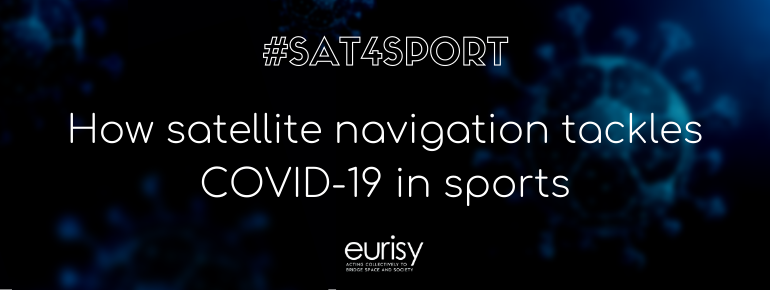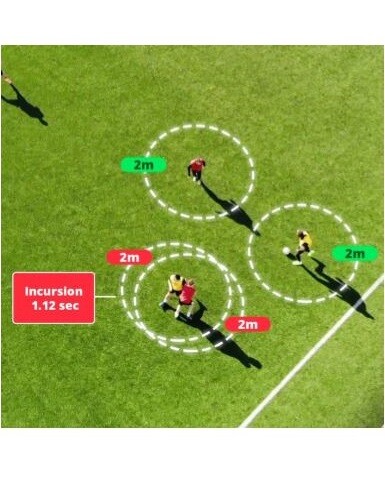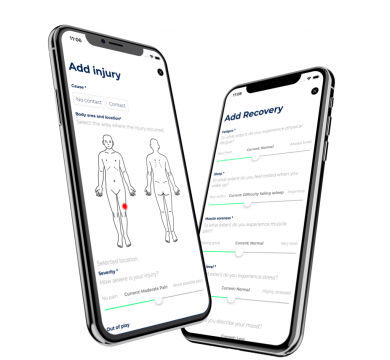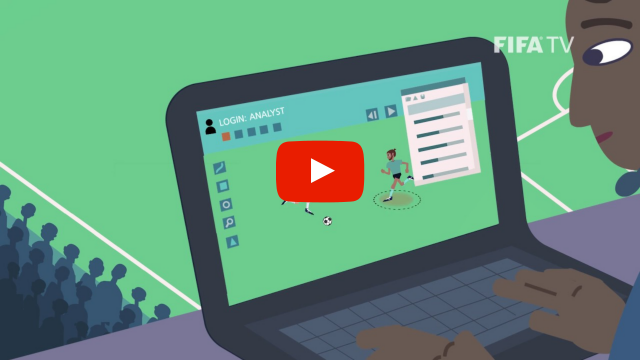How satellite navigation tackles COVID-19 in sports

In this second episode of our Sat4Sport series, we explore how Global Navigation Satellite System (GNSS) technology counters the ongoing pandemic in sports. We describe how satellite navigation is applicable as a tool for the general public in amateur performance tracking, as well as on the highest level for professional teams. Just as every other sector, sports face unprecedented circumstances. However, space assets never ceased to support the industry, enabling innovative solutions both at grassroots and elite level.
The widespread of fitness wearables
The spike in performance monitoring at amateur level with tracking devices and mobile apps is an indicator of the appetite for physical data amongst the general population nowadays. Driven by the trend of democratisation of sports and fitness equipment for all ages, fitness wearables represent the largest segment of the GNSS wearables market, reaching €13 billion in 2018 and expecting to reach 5.2% annual growth through 2023. When it comes to amateur performance monitoring, GNSS-enabled wearables comprise mainly wrist-worn devices such as watches and bracelets. An increasing number of smartphone services and fitness-related applications are compatible with these wearables. Whether you like to run in the city, cycle in the countryside, hike in the mountains, swim in the sea, or prefer any other outdoor activity, there will be a multitude of options available covering a wide variety of needs such as planning routes and calculating average speed or covered distance.
Since users can track their biometric data over time, smartwatches also operate as a digital health system. Parameters around heart rate, blood oxygen level, sleep, stress level, and movement change can alert users about a possible COVID-19 infection.
Lockdown challenges
Popular fitness apps such as Runkeeper or Strava have tens of millions users across the world. The apps are used to keep track of activity history and performance data, mostly for running and cycling. These platforms are becoming the social media of sports allowing both amateur and professional athletes to upload their recorded workouts with any GNSS enabled device, and to connect online with their friends and followers.

During the first wave of the corona breakout, the use of these apps increased drastically. According to mobile operator EE, the Strava fitness app user count and data usage tripled across the UK compared to pre-lockdown figures. While one event after another was cancelled due to COVID-19, sports enthusiasts and professional athletes turned towards online sports community platforms to keep themselves engaged. Different challenges encourage users to stay active with all kinds of rewards such as digital trophies, shopping vouchers, or charity sponsoring.
Virtual events
Online platforms even allowed for some forms of competition, since participants exercise remotely and just need to upload their GNSS data on a platform. One such online platform is Keep Moving, offering digital challenges for events that could not take place as planned.
For instance, like so many other events the Tour of Belgium – a five-day bicycle race held annually – was cancelled this year due to COVID-19. However, a virtual alternative was organised instead. For the first time, the race was open for participants across the whole country. Amateur cyclists were divided in separate teams represented by one professional rider. Ultimately, the team with the highest recorded distance would be the winner. With more than 3000 active participants keeping track of their rides, and with an average of around 200 km per person spread over 5 consecutive days, the country lived up to its cycling geek reputation.

Remote training during lockdown, social distancing and returning to contact sports
Satellite navigation also provides tools to keep professional athletes as fit as possible. Tracking systems have been highly effective during the lockdown when competitions abruptly stopped and training accommodations were closed. The data also enabled coaches to remotely track the performance of their athletes if they would exercise at home.
The COVID-19 pandemic created a unique situation where players and athletes had enforced inactivity from competition and even training during an unusual period. Although a period of inactivity allows players to recover and regenerate, the associated negative effect is detraining leading to a potential decrease of technical but also physical abilities. Moreover, some competitions had to be rushed during summer to complete the season, requiring players to come back in a very short amount of time increasing risk of injury. Monitoring technology is essential to set the objectives and to ensure that athletes are achieving according to the prescribed programme to avoid overloading or under exposure. A large body of evidence and literature in sports science building upon data generated by GNSS tracking wearables, is dedicated to how training and competition workloads relate to injuries and how loading schemes can be optimised.
 As most outdoor team sports imply physical contact between players, GNSS technology and video analysis also contribute to a smooth transition towards team-based training activities in a socially distanced manner. Research such as the player proximity report by STATSports, studying the frequency of close contacts and the duration of these incursions, provides coaches more information on how to better modify trainings according to social distancing guidelines. In order to avoid as much as possible prolonged close contacts in competitive play, some companies are open to the idea of creating heat maps based on the data generated by their tracking devices to study player movements. Another idea is to introduce a shot clock, a time frame within which the game needs to be resumed especially during dead ball situations when players are packed together.
As most outdoor team sports imply physical contact between players, GNSS technology and video analysis also contribute to a smooth transition towards team-based training activities in a socially distanced manner. Research such as the player proximity report by STATSports, studying the frequency of close contacts and the duration of these incursions, provides coaches more information on how to better modify trainings according to social distancing guidelines. In order to avoid as much as possible prolonged close contacts in competitive play, some companies are open to the idea of creating heat maps based on the data generated by their tracking devices to study player movements. Another idea is to introduce a shot clock, a time frame within which the game needs to be resumed especially during dead ball situations when players are packed together.
In the Bundesliga – the highest football league in Germany – players returned straight into competition without preseason friendlies following the COVID-19 lockdown. Although the league introduced additional breaks during match play and allowed more substitutions, the condensed fixture schedule to finish the season off resulted in injury spikes 2 to 4 times higher than pre-lockdown. A similar effect is expected in other leagues, as well as in other sports. Returning players to contact has particular relevance in rugby where home confinement due to the pandemic exposed athletes to unprecedented levels of detraining. While skills and running could have been provided, players were no longer exposed to a contact stimulus. Rugby is a sport where high impacts occur frequently, so players need special care after their prolonged period of inactivity to minimise the risk of injury when returning back to contact competition demands.
 The GNSS data, which already shows coaches the training load of their players, can be complemented with information about how a player is feeling including sleep, stress levels, and even mood levels. Mobile apps such as the JOHAN Team Performance App or the Athlete Management System from Catapult Sports provide sports scientists and medical teams with even more indicators about player performance. In response to the COVID-19 pandemic this enabled players to upload their wellness parameters together with their training data, and coaches to detect early symptoms remotely.
The GNSS data, which already shows coaches the training load of their players, can be complemented with information about how a player is feeling including sleep, stress levels, and even mood levels. Mobile apps such as the JOHAN Team Performance App or the Athlete Management System from Catapult Sports provide sports scientists and medical teams with even more indicators about player performance. In response to the COVID-19 pandemic this enabled players to upload their wellness parameters together with their training data, and coaches to detect early symptoms remotely.
Enhancing the at-home fan experience
Now that major sports competitions have finally picked up again, leveraging on generated data during the game could compromise for the lack of crowds inside the stadium and improve fan engagement through live broadcasting. Detailed stats such as covered distance, sprint speeds or heart rates during a penalty shootout, will surely captivate viewers from their homes. Satellite communications and increased broadband already increased connectivity allowing sports fans to engage with each other online, watch instant replays, or check in on other games during game down times. With additional data on player and team stats, sports-viewing technology will further improve the at-home fan experience.
Overcoming the crisis
At amateur level, satellite navigation devices have become widespread. Smartwatches or even mobile phones, in combination with sports apps gave rise to a digital sports community. Online platforms dealt with the mass cancellation of sports events and have stimulated people to stay active even when confined.
Despite the major setbacks due to the current sanitary crisis, the future of data in sports seems secure. Analysing training data has become an essential tool in a professional environment for the fine tuning of training programmes, but also for many other aspects of outdoor team sports. Recent events underlined the benefits of GNSS wearables. The trackers enabled coaches to monitor their players remotely and assisted trainers to restart group sessions while also respecting social distancing. The use of satellite navigation data in sports performance monitoring is very diverse and is used in different sports. The data even opens up new opportunities to enhance audience experience during these unprecedented times.
Satellite navigation technology is an all-round champion when it comes to sports performance monitoring!

